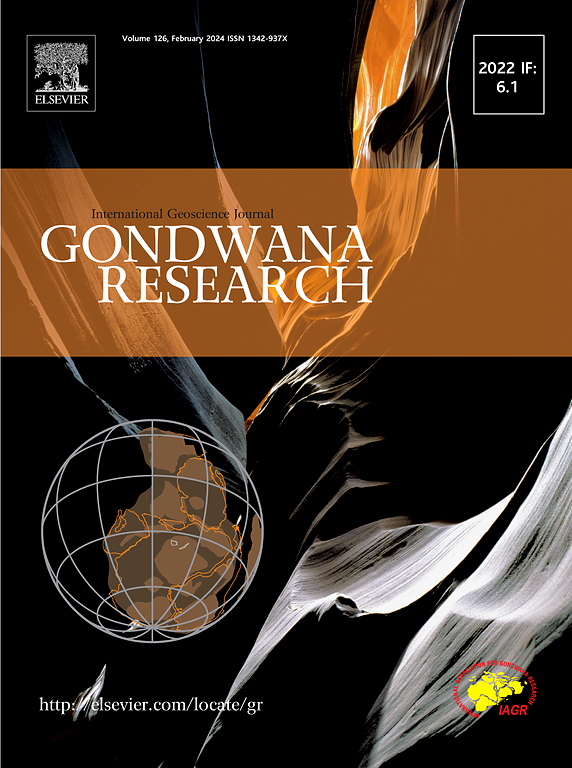揭示华南~ 110 Ma大陆弧:来自东海盆地近海岩浆记录的地球化学和同位素信息
IF 7.2
1区 地球科学
Q1 GEOSCIENCES, MULTIDISCIPLINARY
引用次数: 0
摘要
古太平洋板块的回退被广泛认为是早白垩世华南岩浆带向海沟迁移的驱动因素。然而,在117 ~ 108 Ma之间,由于弧安山岩的缺乏和岩浆活动的明显停止,引发了关于构造模式的争论。值得注意的是,东中国海近海盆地(ECSB)的岩浆作用在很大程度上被忽视了。本文对东西部地区10口工业井的21个岩浆岩样品进行了综合分析。通过薄片岩石学、原位锆石U-Pb测年、Hf同位素和全岩地球化学分析,我们确定这些样品为花岗岩、安山岩和凝灰岩,年龄为~ 110 Ma (107.9-112.9 Ma)。样品中富大离子亲石元素(LILEs,如Ba、K、Pb、Sr和Nd),贫高场强元素(hfse,如Nb、Ta、P和Ti)和轻稀土元素(lree),未见Eu异常。所有花岗岩均为i型花岗岩,CaO含量低(0.8 ~ 2.8%),Na2O含量高(3.7 ~ 4.6%),Nb、Rb、Y、Yb、Ta含量低,属于火山弧构造环境。安山岩形成于大陆弧环境,其低Sc含量(3.3 ~ 15.3 ppm)表明。锆石Hf同位素εHf(t)值略负(−0.1 ~−6.3),与陆相较为负(−5 ~−10)形成鲜明对比,表明近海岩浆岩中地幔源物质的贡献较大。总的来说,这些数据表明存在一个从福建东北部延伸到ECSB的~ 110 Ma大陆弧,相对于早期的陆上弧,它经历了明显的顺时针旋转。我们认为古太平洋板块的非同步回滚促进了这条弧的东移,同时将华南陆地置于弧后构造环境中,时间为~ 110 Ma。本文章由计算机程序翻译,如有差异,请以英文原文为准。

Unveiling the ∼110 Ma continental arc in South China: geochemical and isotopic insights from offshore magmatic records in the East China Sea Basin
The rollback of the paleo-Pacific plate is widely believed to have driven the trenchward migration of the magmatic belt in South China (SC) during the Early Cretaceous. However, the lack of arc andesite and the apparent cessation of magmatism between 117 and 108 Ma in the onshore region has sparked debates regarding the tectonic models. Notably, magmatism in the offshore East China Sea Basin (ECSB) has been largely overlooked. This study presents a comprehensive analysis of 21 magmatic rock samples from 10 industrial wells in the ECSB. Through thin-section petrography, in situ zircon U–Pb dating, Hf isotopes, and whole-rock geochemical analyses, we identified these samples as granites, andesites and tuff with ages of ∼110 Ma (107.9–112.9 Ma). The samples are enriched in large ion lithophile elements (LILEs, such as Ba, K, Pb, Sr, and Nd), and depleted in high field strength elements (HFSEs, like Nb, Ta, P, and Ti) and light rare earth elements (LREEs), with no Eu anomalies observed. All the granites are I-type granites, characterized by low CaO (0.8–2.8 %) and high Na2O (3.7–4.6 %) contents, as well as low Nb, Rb, Y, Yb, and Ta contents, suggesting a volcanic arc tectonic setting. The andesites, formed in a continental arc environment, as suggested by their low Sc contents (3.3 ∼ 15.3 ppm). Zircon Hf isotopes show slightly negative εHf(t) values (−0.1 to −6.3), which contrast with the more negative onshore values (−5 to −10), indicating a higher contribution of mantle-derived material in the offshore magmatic rocks. Collectively, these data suggest the existence of a ∼110 Ma continental arc extending from NE Fujian to the ECSB, which underwent significant clockwise rotation relative to earlier onshore arcs. We propose that asynchronous rollback of the paleo-Pacific plate facilitated the eastward migration of this arc, while placing onshore South China in a back-arc tectonic setting during ∼110 Ma.
求助全文
通过发布文献求助,成功后即可免费获取论文全文。
去求助
来源期刊

Gondwana Research
地学-地球科学综合
CiteScore
12.90
自引率
6.60%
发文量
298
审稿时长
65 days
期刊介绍:
Gondwana Research (GR) is an International Journal aimed to promote high quality research publications on all topics related to solid Earth, particularly with reference to the origin and evolution of continents, continental assemblies and their resources. GR is an "all earth science" journal with no restrictions on geological time, terrane or theme and covers a wide spectrum of topics in geosciences such as geology, geomorphology, palaeontology, structure, petrology, geochemistry, stable isotopes, geochronology, economic geology, exploration geology, engineering geology, geophysics, and environmental geology among other themes, and provides an appropriate forum to integrate studies from different disciplines and different terrains. In addition to regular articles and thematic issues, the journal invites high profile state-of-the-art reviews on thrust area topics for its column, ''GR FOCUS''. Focus articles include short biographies and photographs of the authors. Short articles (within ten printed pages) for rapid publication reporting important discoveries or innovative models of global interest will be considered under the category ''GR LETTERS''.
 求助内容:
求助内容: 应助结果提醒方式:
应助结果提醒方式:


